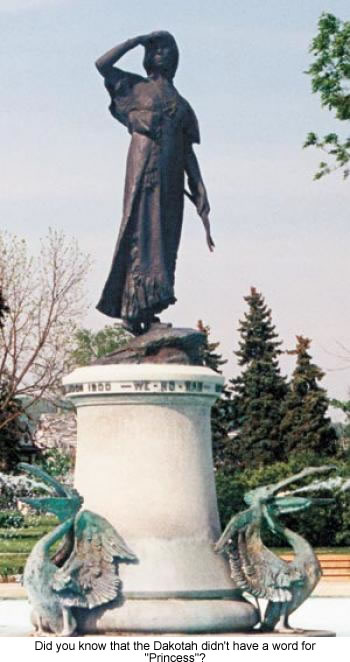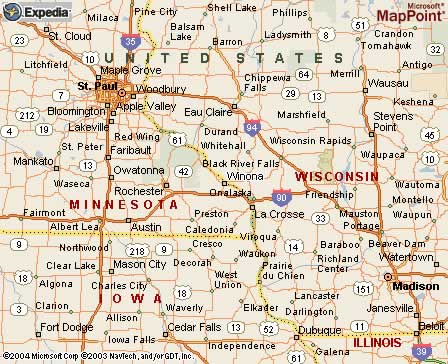 |
Canku Ota
|
 |
|
(Many Paths)
|
||
|
An Online Newsletter
Celebrating Native America
|
||
|
March 1, 2009 - Volume
7 Number 3
|
||
|
|
||
|
Homecoming To Explore
Roles Of American Indian Women
|
||
|
by Cynthya Porter -
The Winona Post
|
||
|
credits: Photo from Winona
Post archives
|
|
In anticipation of the upcoming Dakotah Homecoming during which several women will be recognized, this is the first in a series exploring the roles American Indian women have played both in their cultures and that of the white settlers.
Wenonah, which literally translated from the Dakotah language means firstborn daughter, is said to have been the child of Chief Wapasha, leader of the band of Dakotah that called this region home when white settlers first stepped off boats in the 1850s. The legends that have surrounded her life and death since days when the Dakotah lived here are many, though all carry a central theme: Princess Wenonah’s father was going to force her to marry someone she didn’t love, so she leaped to her death from hundreds of feet above the Mississippi River at a place called Maiden Rock. According to research compiled by Winonan Monica DeGrazia, sometimes the story is that she is to marry within her own tribe though she loves someone from an enemy tribe, sometimes it is that her father wants to wed her to a brave from a neighboring tribe to build relations. There is even a version that the supposed arranged marriage was to be to a French trapper in exchange for blankets and food. DeGrazia found more than 40 versions published over the past 200 years, the undisputed first a few sentences penned by Zebulon Pike in 1805. Pike didn’t say exactly who shared the story with him during his trip up the Mississippi, but he noted in his journal a sketchy story about an Indian maiden who dashed herself on the rocks rather than marry one she didn’t love. Over the years, according to DeGrazia and encyclopedia entries on the matter, the story began to take on more detail as other visitors to the area retold it, with the maiden becoming Princess Wenonah and her home Keoxa, later known as Winona. Some versions, however, say Wenonah was from the Fort Snelling area, only visiting the bluffs around Lake Pepin to hunt for porcupines. But all have her as a lovely princess maiden, burdened by unrequited love and her powerlessness against the wishes of her family. But at the risk of being spoilsports to a romantic tale, historians say there are a few problems with the story that many have argued as truth over the years. Research suggests that in the Dakotah language, the word “Wenonah” is more a designation than a personal name, much like the words “grandma,” “great-grandma” or “uncle” are to us today. It refers to the first-born daughter of any family, tribal chief or not, and it is only in modern times that it would likely be used as an actual first name. Few dispute that any of the generations of Chief Wapashas may have had a daughter, but what their tribal names were and whether any of them actually dashed herself on the rocks is another matter. Also, Dakotah Indians do not have a designation of “princess,” that is a fabrication by white people, researchers say. In fact, there is not even an equivalent word to princess in the Dakotah language. The truth of the matter is that settlers of European descent have been infatuated with the mystique of American Indian women since Pocahontas supposedly saved John Smith in 1607. There are many, many Princess Wenonah legends that can be found all across the Midwest, as well as other kinds of “Indian princess” legends from one coast to the other. And storytellers universally appear apt to translate Native American relationships through Caucasian eyes, assigning roles and power within an Indian family that do not traditionally exist, author and American Indian expert Rayna Green has written over and over. In Native American families, women are powerful, revered even for their spirituality. They control property; they are the only people who can hold certain sacred items, and today many tribes are being led by them. They also, she says, had a great deal of influence over who they married. In a series of books that seek to set the record straight, Green, who is a Cherokee Indian and director of the American Indian Program for the National Museum of American History at the Smithsonian Institution, explains that many of these legends, while romantic and exotic, are a product of fanciful imaginations rather than the helpless plight of a country full of American Indian princesses. |
|
|
www.expedia.com |
|
|
||
|
|
||
| Canku Ota is a free Newsletter celebrating Native America, its traditions and accomplishments . We do not provide subscriber or visitor names to anyone. Some articles presented in Canku Ota may contain copyright material. We have received appropriate permissions for republishing any articles. Material appearing here is distributed without profit or monetary gain to those who have expressed an interest. This is in accordance with Title 17 U.S.C. Section 107. | ||
|
Canku Ota is a copyright ©
2000, 2001, 2002, 2003, 2004, 2005, 2006, 2007, 2008, 2009 of Vicki
Barry and Paul Barry.
|
||
 |
 |
|
|
The "Canku
Ota - A Newsletter Celebrating Native America" web site and
its design is the
|
||
|
Copyright ©
1999, 2000, 2001, 2002, 2003, 2004, 2005,
2006, 2007, 2008 of Paul C.
Barry.
|
||
|
All Rights Reserved.
|
||
 There
is perhaps no one more enamored with the legend of Princess Wenonah,
said to be Winona’s namesake, than the town itself, with her
image immortalized in bronze, advertising pieces and our imaginations
for at least a century.
There
is perhaps no one more enamored with the legend of Princess Wenonah,
said to be Winona’s namesake, than the town itself, with her
image immortalized in bronze, advertising pieces and our imaginations
for at least a century. 